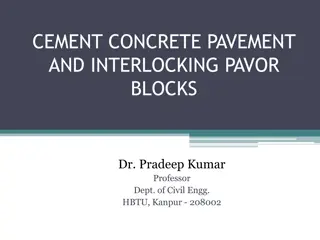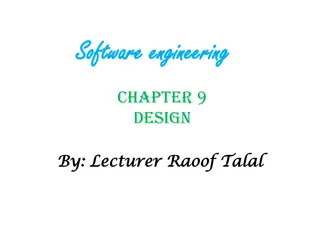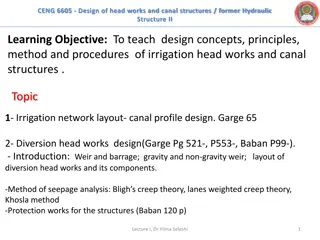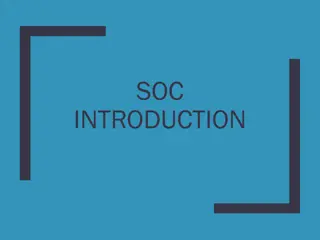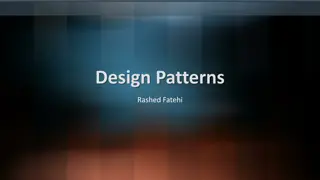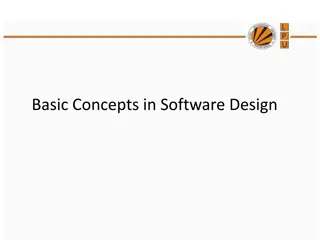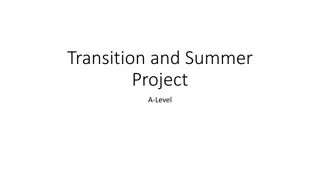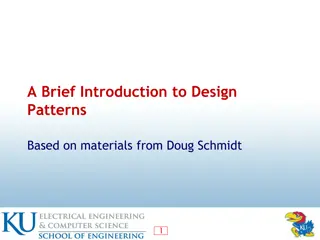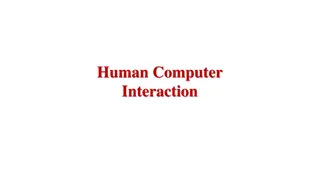
Optimizing Spectrum Usage in IEEE 802.11 Standards
Explore techniques to suppress discrete spectrum components in PPDUs using midamble randomization in IEEE 802.11 standards. Learn about symbol randomization, midamble design, and MIMO PPDU application to enhance wireless communication efficiency.
Uploaded on | 0 Views
Download Presentation

Please find below an Image/Link to download the presentation.
The content on the website is provided AS IS for your information and personal use only. It may not be sold, licensed, or shared on other websites without obtaining consent from the author. If you encounter any issues during the download, it is possible that the publisher has removed the file from their server.
You are allowed to download the files provided on this website for personal or commercial use, subject to the condition that they are used lawfully. All files are the property of their respective owners.
The content on the website is provided AS IS for your information and personal use only. It may not be sold, licensed, or shared on other websites without obtaining consent from the author.
E N D
Presentation Transcript
March 2020 doc.: IEEE 802.11-20/0682r3 Midamble design Date: 2020-04-29 Authors: Name Miguel L pez Affiliations Ericsson Address Phone email Miguel.m.lopez@ericsson.co m Leif Wilhelmsson Ericsson Submission Slide 1 Miguel L pez, Ericsson
March 2020 doc.: IEEE 802.11-20/0682r3 Abstract The TGbd group has agreed to investigate techniques to suppress discrete spectrum components in PPDUs with midambles [1] This contribution describes and evaluates a technique based on midamble randomization It is proposed to include midamble randomization in the design of 802.11bd PPDUs Submission Slide 2 Miguel L pez, Ericsson
March 2020 doc.: IEEE 802.11-20/0682r3 Recap symbol randomization in 802.11ba The 802.11ba PHY is utilizes ON-OFF Keying. The TGba draft [2] recommends randomization of the OFDM symbol representing ON in order to suppress discrete components in the spectrum Reference [3] introduced a low complexity symbol randomization technique. In a nutshell, a pseudo-random sequence of ? s is generated and applied to the ON signal resulting in a phase randomized ON waveform. BPSK mapper PN bit sequence PN sequence of +1 and -1 LFSR ON Phase randomized ON waveform waveform generator Submission Slide 3 Miguel L pez, Ericsson
March 2020 doc.: IEEE 802.11-20/0682r3 Midamble Randomization in TGbd It is proposed to utilize a method similar to that adopted by 802.11ba, consisting of generating a pseudo-random sequence of ? s and multiplying each midamble by one of these values Suppose that a PN sequence ?? consisting of ? has been generated. In the case of SISO PPDUs, the midambles are randomized as shown below MMA data field symbols MMA data field symbols MMA data field symbols ... ... ... ... ... 2nd n-th preamble 1st midamble midamble midamble LTF 1 LTF 1 LTF 1 X X X p1 p2 pn Submission Slide 4 Miguel L pez, Ericsson
March 2020 doc.: IEEE 802.11-20/0682r3 Midamble Randomization in TGbd - MIMO PPDU In case of MIMO PPDUs there are two alternatives Option 1: different pseudo-random sequences are applied to the LTFs in a midamble The same phase shift ??must be applied to both layers MMA data field symbols MMA data field symbols MMA data field symbols ... ... ... ... ... 2nd n-th TX1 preamble 1st midamble midamble midamble LTF 1 LTF 2 LTF 1 LTF 2 LTF 1 LTF 2 X X X X X X p3 p1 p2n-1 p4 p2 p2n LTF 1 LTF 2 LTF 1 LTF 2 LTF 1 LTF 2 MMA data field symbols MMA data field symbols MMA data field symbols ... ... ... midamble... midamble ... 2nd n-th TX2 preamble 1st midamble Submission Slide 5 Miguel L pez, Ericsson
March 2020 doc.: IEEE 802.11-20/0682r3 Midamble Randomization in TGbd - MIMO PPDU Option 2: the same pseudo-random sequence is applied to all LTFs in a midamble. The same phase shift ??must be applied to both MIMO layers MMA data field symbols MMA data field symbols MMA data field symbols ... ... ... ... ... 2nd n-th TX1 preamble 1st midamble midamble midamble LTF 1 LTF 2 LTF 1 LTF 2 LTF 1 LTF 2 X X X X X X p1 p2 pn LTF 1 LTF 2 LTF 1 LTF 2 LTF 1 LTF 2 MMA data field symbols MMA data field symbols MMA data field symbols ... ... ... midamble... midamble ... 2nd n-th TX2 preamble 1st midamble Submission Slide 6 Miguel L pez, Ericsson
March 2020 doc.: IEEE 802.11-20/0682r3 Midamble and Data Randomization in TGbd The ???data field symbols immediately following the n-th midamble and preceding the (n+1)-th midamble may also be multiplied by the same pseudo-random value ??as the n-th midamble [4] The advantage of this method is that if the channel estimate used for the demodulation of the data is based only on the preceding midamble, then the midamble randomization is transparent to the receiver (i.e. the receiver could process the PPDU in the same way regardless of the value of ??) Submission Slide 7 Miguel L pez, Ericsson
March 2020 doc.: IEEE 802.11-20/0682r3 Midamble and Data Randomization in TGbd MMA data field symbols MMA data field symbols MMA data field symbols ... ... ... ... ... 2nd n-th preamble 1st midamble midamble midamble ... LTF 1 LTF 1 LTF 1 X X X One spatial stream p1 pn p2 MMA data field symbols MMA data field symbols MMA data field symbols ... ... ... ... ... 2nd n-th TX1 preamble 1st midamble midamble midamble LTF 1 LTF 2 LTF 1 LTF 2 LTF 1 LTF 2 ... MIMO PPDU X pn p1 p2 X X LTF 1 LTF 2 LTF 1 LTF 2 LTF 1 LTF 2 MMA data field symbols MMA data field symbols MMA data field symbols ... ... ... midamble... midamble ... 2nd n-th TX2 preamble 1st midamble Submission Slide 8 Miguel L pez, Ericsson
March 2020 doc.: IEEE 802.11-20/0682r3 Remarks The Appendix contains a theoretical demonstration that midamble randomization suppresses the discrete spectrum components. In the MIMO case, randomization of the phase could destroy the orthogonality property of the P matrix, which is necessary for channel estimation. The procedures suggested in slides 5 and 6 preserve the orthogonality of the P matrix because they are equivalent to multiplying zero, one or two columns of the P matrix by -1. These operations preserve the orthogonality of the P matrix. Submission Slide 9 Miguel L pez, Ericsson
March 2020 doc.: IEEE 802.11-20/0682r3 Generation of the PN sequence Option 1: use the sequence defined in (17-25) of IEEE 802.11-2016. This is the sequence used to control the polarity of the pilot subcarriers. This sequence consists of 127 values and can be extended cyclically to any length Option 2: generate a PN sequence by means of the LFSR described in Section 20.3.9 of IEEE 802.11-2016. If the shift register is initialized with ones then the same PN sequence as in option 1 above is obtained Option 3: other PN generator Submission Slide 10 Miguel L pez, Ericsson
March 2020 doc.: IEEE 802.11-20/0682r3 Transmitter and Receiver processing The complexity of the transmitter processing is low. The phase shift can be applied to the midamble LTFs in either time or frequency domains. Receiver processing also has low complexity, as it is the reverse of the transmit processing, and may also be performed in time or frequency domains. Submission Slide 11 Miguel L pez, Ericsson
March 2020 doc.: IEEE 802.11-20/0682r3 Simulation results The PN sequence has been generated according to option 1 in slide 7. Preamble periodicity ???= ? (worst case scenario) Resolution bandwidth 3 kHz (worst case scenario) PPDU bandwidth 10 MHz No LTF compression Maximum power over sliding 3 kHz window relative to PPDU with random data PPDU without midamble (Reference) PPDU with midamble, no randomization PPDU with midamble, randomization opt 1 PPDU with midamble randomization opt 2 ??? 1 2 0 dB 0 dB 6.1 dB 10.8 dB 0.4 dB 0.4 dB same as opt 1 1.8 dB Submission Slide 12 Miguel L pez, Ericsson
March 2020 doc.: IEEE 802.11-20/0682r3 Summary A low complexity technique to randomize the midambles has been described and it has been shown that it is effective in suppressing discrete components in the PSD It is proposed to introduce this midamble randomization procedure in TGbd Several implementation options were presented, having minor differences. Submission Slide 13 Miguel L pez, Ericsson
March 2020 doc.: IEEE 802.11-20/0682r3 Straw poll 1 Do you agree that the suppression of discrete spectrum components in PPDUs with midambles shall include a randomization of the midambles achieved by multiplying the midambles by a pseudo-random sequence of ? s? [Note: The exact randomization procedure is the subject of the next straw poll] Y: 11 N: 0 A: 10 Submission Slide 14 Miguel L pez, Ericsson
March 2020 doc.: IEEE 802.11-20/0682r3 Straw poll 2 Which randomization method for PPDUs with midambles do you prefer? A) Each LTF in a midamble is multiplied by a pseudo-random value ?. In the case of MIMO PPDUs, the same pseudo-random value is applied to both spatial streams. The data part of the PPDU is not randomized The method is illustrated in slides 4 and 5 B) All LTFs in a midamble are multiplied by a pseudo-random value ?. The data symbols immediately following any given midamble are multiplied by the same pseudo-random value as said midamble In the case of MIMO PPDUs, the same pseudo-random value is applied to both spatial streams. The method is illustrated in slide 8 A 5/B 8/Abstain 23/ Slide 15 Submission Miguel L pez, Ericsson
March 2020 doc.: IEEE 802.11-20/0682r3 Straw poll 3 Which method to generate the PN sequence used to randomize the midambles do you prefer? A) Use the PN sequence defined in (17-25) of IEEE 802.11-2016 (this is the sequence used to randomize the pilots) B) Some other method A 18/B 0/Abstain 15 Submission Slide 16 Miguel L pez, Ericsson
March 2020 doc.: IEEE 802.11-20/0682r3 Motion Move to include the following text to section 3 of the 11bd SFD PPDUs with midambles shall be randomized in order to suppress discrete spectrum components. The midambles symbols shall be multiplied by pseudo-random values plus/minus one. The data symbols immediately following any given midamble shall be multiplied by the same pseudo- random value as said midamble. In the case of MIMO PPDUs, the same pseudo-random values shall be applied to both symbols of the midamble. The pseudo-random values are defined in (17-25) of IEEE 802.11-2016 Submission Slide 17 Miguel L pez, Ericsson
March 2020 doc.: IEEE 802.11-20/0682r3 References [1] M. L pez and L. Wilhelmsson Remark on PPDUs with midambles , IEEE 802.11-20/0476r1 https://mentor.ieee.org/802.11/dcn/20/11-20-0476- 01-00bd-remark-on-ppdus-with-midambles.pptx [2] Draft standard 802.11ba D6.0 [3] S. Shellhammer et al. WUR Power Spectral Density , IEEE 802.11- 18/0824r1, https://mentor.ieee.org/802.11/dcn/18/11-18-0824-01-00ba-wur- power-spectral-density.pptx [4] Discussion in TGbd during the presentation of 11-20/0682r0 between IEEE SA member Rui Yang and the presenter Submission Slide 18 Miguel L pez, Ericsson
March 2020 doc.: IEEE 802.11-20/0682r3 Appendix In this appendix it is shown theoretically that suppression of discrete spectrum components can be achieved by randomization of the phase of the midambles. Notation ??,?: data or pilot frequency domain symbol (M : data or pilot frequency domain symbol (M- -QAM) corresponding to subcarrier subcarrier ? and OFDM symbol number and OFDM symbol number ?, which are assumed to be independent and have unit power independent and have unit power ??: LTF frequency domain symbol corresponding to subcarrier : LTF frequency domain symbol corresponding to subcarrier ?. . ??: phase shift in : phase shift in ?- -th subcarrier due to GI/CSD (independent of the data) th subcarrier due to GI/CSD (independent of the data) ????: OFDM symbol duration, including the GI : OFDM symbol duration, including the GI ?: subcarrier spacing : subcarrier spacing ?(?): rectangular window, with value 1 if : rectangular window, with value 1 if ? ? < ????and 0 otherwise QAM) corresponding to , which are assumed to be and 0 otherwise Submission Slide 19 Miguel L pez, Ericsson
March 2020 doc.: IEEE 802.11-20/0682r3 Appendix ???: highest data subcarrier index : highest data subcarrier index ?: The total number of OFDM symbols in the signal is : The total number of OFDM symbols in the signal is ??. The following deterministic sequence is introduced to describe the baseband signal with midambles ??= ? ?? ??? ? ?? ???? ?????? ?? ? ???????? ? Finally, a sequence of random phase shifts is introduced. ??: independent binary random variables with independent binary random variables with?[??= ?] = ?[??= ?] =1/2. These are the random phase shifts imparted to the midambles in 1/2. These are the random phase shifts imparted to the midambles in order to suppress the spectral lines. These random variables are also order to suppress the spectral lines. These random variables are also assumed to be independent from the data symbols assumed to be independent from the data symbols ??,?. . ????????? Submission Slide 20 Miguel L pez, Ericsson
March 2020 doc.: IEEE 802.11-20/0682r3 Appendix The baseband signal ??? is written as the superposition of data and midamble symbols ??? = ??,????? + ??,????????? , where ??? ? ? ??,???(?? ???+??) ??,????? = ?= ? ? ??? ? ????? ?= ??? ? ????(? ?????)?? ?= ??? ??? ????(?? ???+??) ??,????????(?) = ?= ? Submission Slide 21 Miguel L pez, Ericsson
March 2020 doc.: IEEE 802.11-20/0682r3 Appendix The PSD ???? of the continuous time baseband signal is defined as ? ???????(?)? ??????? ? ???? = lim ??????? ????? ? For convenience, the following auxiliary functions are defined (where ???? ? =???(??) ??? = ????(?( ?? ?))?(where ) ) ?? ??? With this notation, it can be verified that ? ? = ?= ??? ??? ? ???? ???? ???? ??????? ? = ???? ??? ? Submission Slide 22 Miguel L pez, Ericsson
March 2020 doc.: IEEE 802.11-20/0682r3 Appendix The expectation in the expression for the PSD can be split into three terms: ???????(?)? ??????? ???????(?)? ??????? = ? ????? ????? ???????,????(?)? ??????? ???????,????(?)? ??????? + ? ????? ????? ???????,????(?)? ??????? ???????,????????(?)? ??????? + ? ? ? ????? ????? ???????,????????(?)? ??????? ???????,????????(?)? ??????? ? ????? ????? Next, each of the terms on the right hand side of the equation is computed. Submission Slide 23 Miguel L pez, Ericsson
March 2020 doc.: IEEE 802.11-20/0682r3 Appendix The computation of the first term relies on the assumption that ? ??,???,? ? ?? ? = ? ??? ? = ? ? ????????? , and the fact that ? ?? = ?= ? ??. . ???????,????(?)? ??????? ???????,????(?)? ??????? = ? ????? ????? ????? ????? ? ? ??? ? ? ??? ? ? ???????(?? ???+??)? ??????? ? ? ???????(?? ???+??)? ??????? ? ? ?? ??,? ? ?? ??,? = ?= ? ?= ??? ?= ? ?= ??? ????? ????? ????? ????? ? ? ? ? ??? ??? ? ? ???????(?? ???+??)? ??????? ? ? ???????(?? ???+??)? ??????? ? ? ?? ? ?? ??,???,? = ?= ? ?= ? ?= ??? ?= ??? ????? ????? ????? ????? ? ? ? ? ??? ??? ? ? ???????(?? ???+??)? ??????? ? ? ???????(?? ???+??)? ??????? ? ?? ? ?? ? ??,???,? = ?= ? ?= ? ?= ??? ?= ??? ????? ????? ? ???? ? ? ??? ? ? ??? ? ? ? ??(?? ???+??)? ??????? ? ? ? ?? = ? ?? ???? ??(?) = ???? ?(?) ? ??. ?= ? ?= ??? ?= ? ?= ??? ?= ? ? Submission Slide 24 Miguel L pez, Ericsson
March 2020 doc.: IEEE 802.11-20/0682r3 Appendix The computation of the second term relies on the assumption that ? ??,??? = ?. ???????,????(?)? ??????? ???????,????????(?)? ??????? = ? ????? ????? ????? ????? ? ? ??? ? ? ??? ? ? ???????(?? ???+??)? ??????? ? ? ???????(?? ???+??)? ??????? ? ? ?? ??,? ???? ?? = ?= ? ?= ??? ?= ? ?= ??? ????? ????? ????? ????? ? ? ? ? ??? ??? ? ? ???????(?? ???+??)? ??????? ? ? ???????(?? ???+??)? ??????? ? ? ???? ??,??? ?? = ?= ? ?= ? ?= ??? ?= ??? ????? ????? ????? ????? ? ? ? ? ??? ??? ? ? ???????(?? ???+??)? ??????? ? ? ???????(?? ???+??)? ??????? ? ???? ? ??,??? ?? = ? ?= ? ?= ? ?= ??? ?= ??? ????? ????? Submission Slide 25 Miguel L pez, Ericsson
March 2020 doc.: IEEE 802.11-20/0682r3 Appendix The computation of the third term relies on the assumption that ? ???? and the facts that ?? ? ?????????, = ? ?? ? = ? ?= ??and ?? ?= ? ???????,????????(?)? ??????? ???????,????????(?)? ??????? = ? ????? ????? ????? ????? ? ? ??? ? ? ??? ? ? ???????(?? ???+??)? ??????? ? ? ???????(?? ???+??)? ??????? ? ???? ?? ???? ?? = ?= ? ?= ??? ?= ? ?= ??? ????? ????? ????? ????? ? ? ? ? ??? ??? ? ? ???????(?? ???+??)? ??????? ? ? ???????(?? ???+??)? ??????? ? ???????? ???? = ?= ? ?= ? ?= ??? ?= ??? ????? ????? ????? ????? ? ? ? ? ??? ??? ? ? ???????(?? ???+??)? ??????? ? ? ???????(?? ???+??)? ??????? ????? ???? ???? = ?= ? ?= ? ?= ??? ?= ??? ????? ????? ? ???? ? ? ??? ? ? ??? ? ? ? ??(?? ???+??)? ??????? ? ? ?? = ?? ???? ??(?) = ???? ?(?) ?? ?= ? ?= ??? ?= ? ?= ??? ?= ? ? Submission Slide 26 Miguel L pez, Ericsson
March 2020 doc.: IEEE 802.11-20/0682r3 Appendix Collecting all the terms, ? ? ? ? ? ???? ? ? ?? ?????? ? ? ? ???? = lim ???? ? ? ? ?? + ???? ? ? ?? = lim = ????? ? . ?????? ? ? ?= ? ?= ? Note that The PSD ???? = ?????(?)does not contain any discrete components The PSD is independent of the proportion ?= ? signal The PSD is independent of the value of the periodicity parameter ???of the midambles ? ? of midambles in the baseband ?? ?? Submission Slide 27 Miguel L pez, Ericsson







